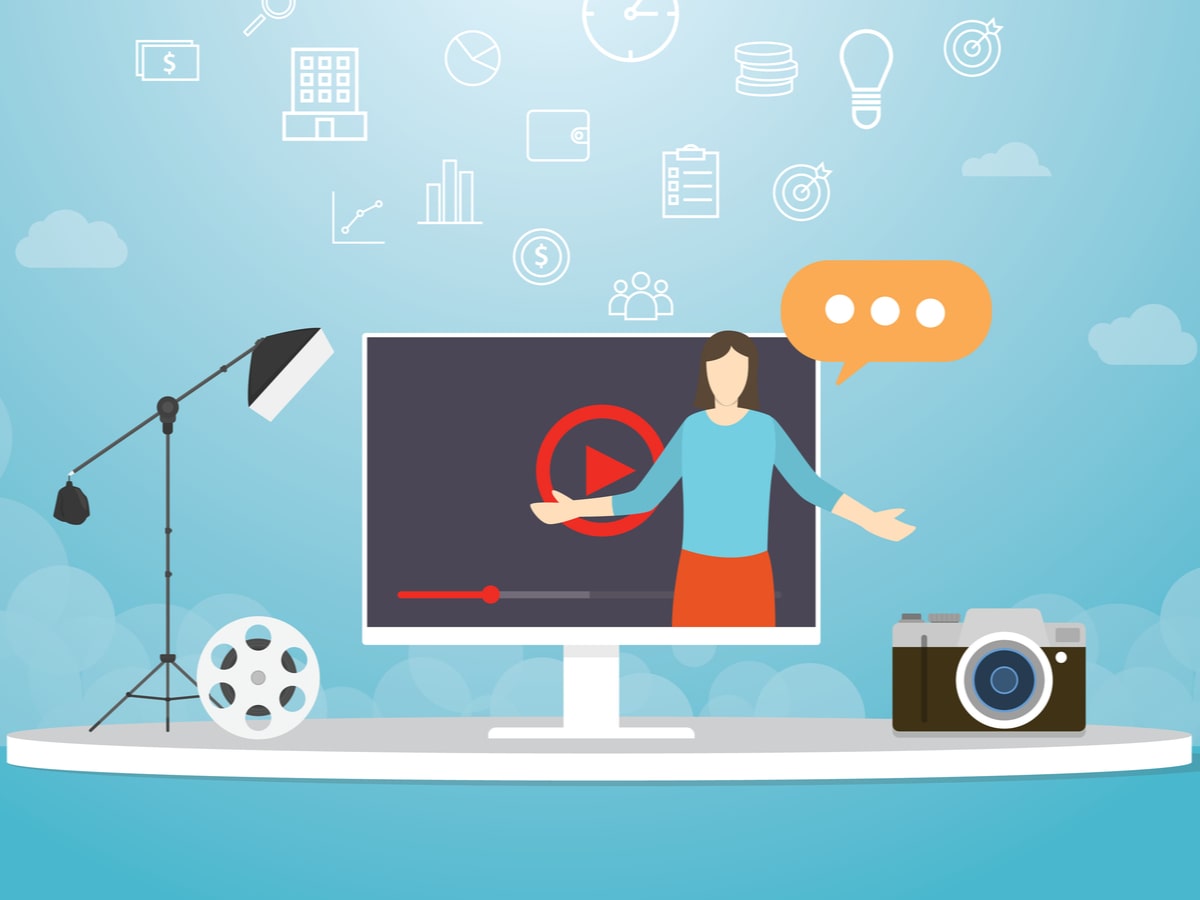In any crowded marketplace, the only way to compete is by making the most of resources, including your “face time” with customers. The more quickly and clearly you explain a product or service, the faster an audience will adopt it. Time is especially valuable for B2B sales because owners and decision-makers are bombarded with marketing offers and other visual clutter. What’s the best way to get attention and convince them to buy? In this post, we’ll take a deep dive into the strategies behind successful B2B explainer videos, and you’ll learn how to use the power of animation to reach viewers and sell products.
Animated explainer videos are trending
- Sales presentations & promotions
- Product demonstrations
- Animated tutorials
Before considering the current status quo in marketing, let’s first acknowledge the past: Animation wasn’t made for adults, it was for children’s cartoons.
So how did we grow from Goofy Duck cartoon characters into B2B explainer videos?
Business animation is so popular now because it’s the most efficient way to use your “face time” with customers.
Business owners and other busy people prefer to learn information from animated videos instead of written content.
Here’s a great example of a super-converting B2B explainer video that our agency made for Purpose HQ. Its characters grab viewers’ attention, and the message is loud and clear.
Notice how the animated characters are introduced and their “pain point” – HR staffing and talent-mismatch issues – is immediately highlighted. Next, a solution to the problem is presented, and everyone is satisfied.
Viewers identify with the characters, and emotions move them to click through your links.
B2B explainer videos are the best way to:
☑ Explain what a company or organization does
☑ Explain a product, service, or anything else
☑ Demonstrate how a process works
☑ Simplify messages or value propositions
☑ Tell memorable stories and drive emotions
How to get the best click-through rates
Now that you’ve seen an example of top-quality business animation, let’s take a closer look at how the medium works.
Then we’ll walk through some other clips that highlight the best characteristics of high-converting videos across a wide range of industries. That way you can learn how to get the best results for your own organization.
Time management is the key to success
Benjamin Franklin said it best:
Do you love life? Then don’t waste time, because time is what life is made of!
As mentioned earlier, successful B2B marketing is based on time management. High-converting animated videos are always short, usually between 30 seconds to a couple of minutes.
Whiteboard videos, hand drawn videos and other types of animation are the quickest way to present new ideas. They let decision-makers instantly assess your products and services.
Here’s an example that shows the power of animated video for saving time while speaking directly to decision-makers. This Genezen turns the super-complex topic of gene therapy into a simple, effective sales presentation.
Notice how it blends together all the various media elements into a powerful symphony to sell the company’s services.
- Lovable animated characters
- On-screen text and graphic elements
- Narrative voice-over and music
OK, we’ve just outlined the reasons why video marketing is so effective. Now it’s time to show how to use that power for your own business.
B2B animated video best practices for 2020 and beyond
While showcasing some of the best artistry that we’ve seen in 2020, let’s highlight the common elements for success in all types of explainer videos.
A balance between formality and creativity
One of the first things you’ll notice is their balance between artistic creativity and business formality. The highest-converting videos are always creative and memorable, yet they’re also “hardworking.”
Check out this explainer video for Siren, a digital security firm:
The topic is cyber-security. If this marketing content were presented with written text, or even in “live-action” video form, it would be more difficult to explain.
Yet, the animated pitch is quick and clear. It’s also relatively non-threatening, which is important for scary topics like security.
Business animation uses entertainment to inform viewers, but the underlying purpose is serious. Of course, it’s critically important to engage and convince decision-makers without wandering off-topic.
It’s also important to avoid stepping on any “landmines” with controversial topics. A leading explainer video agency can find the right voice to entertain and inform viewers without offending anyone.
Animated characters can talk about sensitive issues more easily than live actors, as you’ll see in this video about family planning:
Notice how the animated characters and human voice-over are somehow soothing. And, the message is clear and palatable.
In contrast, imagine how different this message might appear if presented by a real person. Unfortunately, live appearances make it too easy for viewers to react to the messenger instead of focusing the message.
That’s the power of animated video marketing – It uses funny, non-threatening characters to inform viewers about sensitive topics without turning them off.
Speak directly to a receptive audience
Another characteristic of high-converting videos is effectiveness. A good agency can create successful results with a great ROI because salespeople waste less “ammunition” with under-qualified prospects.
But first, the agency must identify a target audience. Then they can craft the perfect message to speak to them.
Whether you’re selling products, teaching tech topics, or informing the public, the power of video messaging arises from its precision.
To reach a specific audience, the team creates a persona that matches the ideal profile of a viewer in that audience.
A persona is the “hero” of the story told in an explainer video
This persona represents a decision-maker who has the power to buy your products, or someone expected to learn about your process. With promotional b2b explainer videos, the highest-converting winners are built around a “hero” who uses a new product or process to solve an old problem.
Sound familiar? A good story is always the foundation on which a successful sale is built.
The magic of animation is in its storytelling power. Whether you’re selling to consumers or businesses, everyone loves to be entertained by a story told with animated characters.
For example, check out this Diageo promotion for Irish-Canadian travel and immigration.
The topic of immigration is boring (yawn). But somehow these cheerful characters keep viewers glued to the screen long enough to learn all the important details about life in Canada.
Think your business is too technical to benefit from video marketing?
Regardless of ho-hum products or complex topics, good videos deliver messages that engage viewers and drive sales.
Define the objectives
Along with focusing on the target audience, successful animation also depends on meeting client goals, which are to inform people and sell things.
Some types of projects, such as educational tutorials, consist of a series of lessons about how to perform a task. The objective of the videos is to provide information, and there are various ways to measure success.
Other kinds of business animation are designed to promote and sell products. The key characteristic of all successful explainer videos is their pinpoint focus on telling a story about solving the viewer’s problem.
It doesn’t matter whether the storyline requires a funny character or a serious one, as long as that story serves a client’s goals – Informing viewers and selling products.
Highlight the problem, and offer a unique solution
Once the audience is identified, the next step is to specify exactly which issue is to be resolved. Viewers are informed and products are sold based on the ability to solve viewers’ problems.
Through expert storytelling, the viewer is first introduced to the video’s hero, which happens to be a marketing persona that matches the viewer. The hero is suffering from a problem which also happens to be the topic of the video.
It’s not a coincidence, it’s a play for affinity.
Next, our hero learns about the benefits of a new product and explores different ways of solving old problems. The video ends with a call-to-action (CTA) to encourage the viewer to take that next step – Buy a product or adopt a process.
Here’s a clip showing excellent storyline progression:
The company is a mining company, Power Ore, and our hero’s character is named “Doctor Copper.” He makes a winning argument in favor of the company’s new mining project.
Choose the best storyteller
Since storytelling is the true key to success, let’s drill down into the kind of storytellers you should look for when choosing an agency to work on your projects.
The steps are simple –
- Introduce a hero and illustrate the hero’s problem
- Demonstrate your product or service to solve the problem
- Highlight the benefits to your hero
- Call viewers into action (CTA) by telling them how to take the next step and buy your product, or take some other desired action
Since storytelling is so important for engaging viewers, educating and convincing them to buy, let’s go over each step in the storytelling process again.
Introduce a hero, and tell a memorable story about them
The best approach is to always use a storyline that instantly grabs and holds attention. In a well-made video, you’ll see a smooth transition between each scene.
Viewers are led through a short-yet-memorable story about a hero. As mentioned earlier, the hero represents the buyer’s “persona.”
Your hero is calling out to the customer persona.
The hero has some type of business problem, social distress, or serious medical condition. The story highlights their suffering. The target audience feels the same pain.
Show a solution for the hero’s problem
After introducing one or more hero characters, the next step is to show how your product or service can resolve their main problem.
An expert team has the creative and technical powers to connect viewers with your hero through their own problems.
Look carefully at this public-service project for Manx Utilities:
It weaves an efficiency recommendation together with a pandemic-related warning for families. This is a great example of showing the entire family as “hero” in the drama.
Focus on benefits instead of features
Another common characteristic shared by high-converting animated videos is their focus on highlighting the benefits of a product, instead of simply listing its features in text format.
It’s especially important to talk about benefits when the topic of a video is tech-heavy or complex. That’s because short videos require a sharp focus on the given topic.
Here’s an example of a “fuzzy” topic made more tangible by using a hand drawn video to list the benefits:
During this animated whiteboard video, viewers’ eyes are glued to the hand that draws benefits, numbers, and other text elements of the Distributel model.
It’s a memorable way of packaging multiple ideas into one simple concept.
Call viewers into action
One of the most notable differences between high-converting videos and “losers” is a standout CTA.
Remember that old proverb “If you do not ask, you shall not receive”?
The final step with any business is a strong call to action. That means telling viewers what to do next – Buy your product, or take some other urgent action.
After entertaining the viewers and giving them valuable information, they’re likelier to reward you in some way – either by clicking through to buy a product, or taking some other action you’ve requested.
Here’s an excellent example of a CTA that drives viewers to contact the client’s insurance agency:
The CTA gives complete contact information and compels its truck-driver audience to act quickly.
A few more lessons from high converting animated video explainers
Now that we’ve highlighted and described what to for in a top-quality B2B explainer video, let’s review a few more great examples. We’ll point out why they work so well.
Use simple visuals to explain complex topics
Many topics in business and technology are too complex to be quickly described with words alone. A few pictures can replace thousands of written words about any tech topic.
When you need to describe any complex process, animation can help simplify the task. The key to success is to let animated video explainer experts create the right visuals to tell your story quickly and clearly.
Check out this high-converting DNA Definitive promotion:
It uses a series of fast-moving vignettes to give a crystal-clear picture of the company’s otherwise-complex business model.
Reach the right B2B marketing “persona”
As mentioned earlier, the most successful animated videos are built to target a precise buyer demographic. The more directly a video’s message speaks to the target audience, the more you’ll sell.
This Eurosirel promo speaks with such a confident tone because it’s designed to reach the target audience with pinpoint accuracy. This is the type of successful result that drives click-throughs.
Takeaways
Video is essential if you want to compete in any B2B marketplace. Animated videos are the most effective way to reach people with your message. Live-action videos are more expensive and less effective than whiteboard videos or hand drawn videos.
When you’re thinking about hiring an agency, assess their experience and talent. Most importantly, look at their storytelling ability. As we’ve highlighted with examples throughout this post, the best videos tell a story you’ll remember for a long time!
Want to simplify your messaging and drive an audience into action? Contact us!





